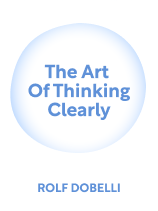

This article is an excerpt from the Shortform book guide to "The Art of Thinking Clearly" by Rolf Dobelli. Shortform has the world's best summaries and analyses of books you should be reading.
Like this article? Sign up for a free trial here .
What is alternative blindness? How does alternative blindness affect decision-making?
Alternative blindness is a decision-making bias where you hone in on two options, neglecting alternatives. This bias can manipulate you to follow other people’s plans. It makes Option A seem like your only choice when a different option could actually suit you better.
Keep reading to learn about alternative blindness bias, why it happens, and how to overcome it.
How to Counter Alternative Blindness Bias
Alternative blindness is where people hone in on two options—where Option A is “standard” and Option B is terrible—to the exclusion of every other option.
To counter alternative bias, Dobelli recommends looking at underrepresented options. Often, a more moderate third option may fit your situation better than the extremes of Options A and B.
For example, many people feel pressured to attend college. The situation is presented as Option A: Go to college and get a good job, vs. Option B: Don’t go to college and don’t get a good job. However, there are other options, including Option C: Go to trade school and get a good job, or Option D: Complete an apprenticeship and get a good job. Option A is considered “standard”, but high tuition can make college a hindrance rather than a help. Looking at the underrepresented options can provide a more fulfilling and profitable experience than falling for alternative bias.
Overcoming Alternative Bias Through Perspective
Dobelli presents the solution to alternative bias as needing to expand your horizons and look to less conventional options. However, others argue that looking at more options isn’t enough to combat the bias. You can feel just as trapped choosing between three or four options as two, they point out.
To overcome this bias, instead of merely increasing the number of options available to you, consider both broadening your horizons and changing your perspective to assess each option logically. Here are a few ways to change your perspective:
- Consider what you have. For instance, Option A: College assumes you can afford tuition. Challenge those assumptions; see where you stand and how that affects your choice.
2. Consider the gains and losses. A loss in one option (for instance, trade school doesn’t have great job mobility) may be a gain in the other (college degrees provide greater job mobility).
3. Consider what’s most important to you. All decisions are somewhat uncertain. Determine what’s important enough that it must be certain, and consider that first when deciding.

———End of Preview———
Like what you just read? Read the rest of the world's best book summary and analysis of Rolf Dobelli's "The Art of Thinking Clearly" at Shortform .
Here's what you'll find in our full The Art of Thinking Clearly summary :
- A detailed look at the most common logical fallacies that inhibit decision-making
- How to recognize and overcome these fallacies to make better decisions
- Why you value things for arbitrary reasons






